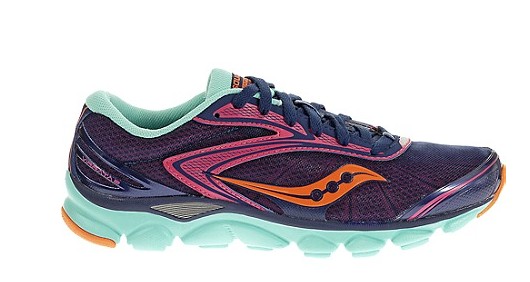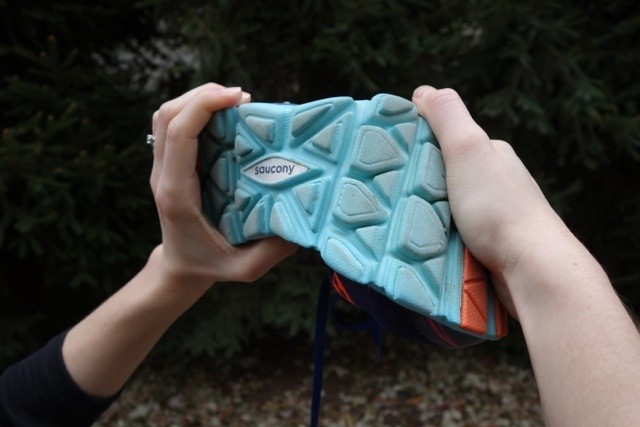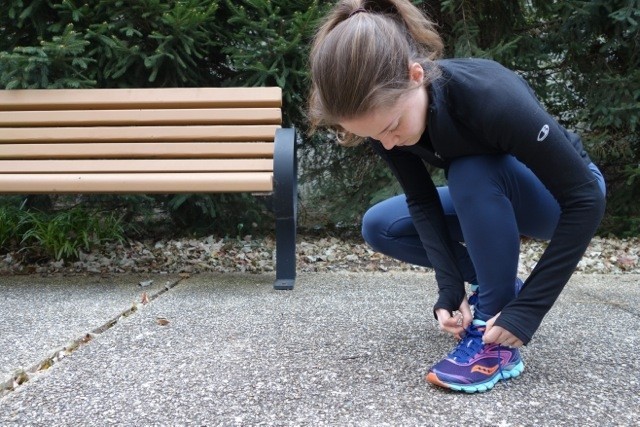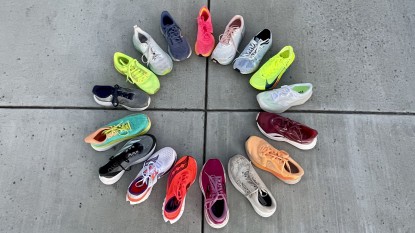The Saucony Virrata 2 is a whisper-weight wonder. We adore running in these shoes and highly recommend them to anyone looking for a more natural running experience. At just $90, this shoe is a steal. The Virrata can really handle almost any application you can think of from your fastest 5k to full-on marathon training. In our comparison reviews, the Saucony killed it in four categories — weight, responsiveness, upper comfort, and breathability. Decreased durability, and a lack of stability features are the trade-offs for such a light and flexible shoe. We feel that the low cost of the Virrata offsets any potential issue, and when compared to the cost vs. durability of traditional shoes in our comparison, the Virrata may even come out ahead.
Who should run in natural running shoes like the Saucony Virrata? Neutral runners with average pronation in their gait shouldn't have a problem. We think this is also a great option if you supinate while running because you are looking at 18mm of cushioning between you and the road and an extremely flexible sole. As a neutral, zero-drop shoe, the Virrata encourages a mid-foot strike, but because there is just so much cushioning in the sole, some may feel comfortable running with a heel-strike, and that would be a bad combination for certain runners. An extreme over or under pronator who doesn't plan on transitioning to a mid-foot landing would wear out the unstructured cushioning in this shoe in an uneven way, thus exacerbating their gait mechanics. Never fear though! Many people with running gaits outside the neutral range have transitioned from heel-strike to mid or forefoot in just this kind of shoe.Saucony Virrata 2 - Women's Review
Our Verdict
Our Analysis and Test Results
Lighten up with the featherweight Saucony Virrata 2, our Top Pick for more 'natural' running. Saucony keeps this model super basic with the road protection of a traditional running shoe without all the bells and whistles. Bonus: the cost savings are passed on to you. This is a great choice for those venturing into natural running or for minimalist runners who crave some cushioning on the roads.
Now, barefoot purists are going to contend that this shoe is not natural at all. It's 18 millimeters off the ground, and any amount of cushioning between your foot and the ground is going to alter your stride. So the bottom line is this: the Saucony Virrata is as unnatural as running mile after mile on concrete. Semantics aside, we love the Virrata for what it is, an unstructured cushioned trainer that's great for alternating with traditional running shoes.
Responsiveness
The Virrata 2 is like a glove. It moves with you wherever you go, which earned it the top spot in responsiveness. Ground feel in this shoe beats out all of the other models we tested, and the sole of the Virrata drops off in the forefoot, providing just a little extra propulsion through toe-off. Flexibility is the key feature in securing this rating, however, and that translates to your foot doing all of the work.
Landing Comfort
Earning a solid 7/10 in landing comfort, the Virrata's 18mm of EVA+ responsive cushioning helps keep you on the road longer. The cushioning is distributed in triangular “pods” that buffer impact through the length of the shoe while maintaining maximum responsiveness. If you usually have a lot of downhills in your run, look to our Editors' Choice, the Brooks Ghost 7, which can better manage the extra high impact. The Hoka Conquest won the top spot in this category, but the ride is nothing like what you'll find in the Virrata.
Upper Comfort
The upper materials and construction in the Saucony Virrata 2 are heaven. The tongue and heel collar are surprisingly well padded and help the Virrata snag another 10/10 in our review. With a sock-like bootie construction, the upper feels seamless and keeps the tongue properly located. You could easily wear this shoe without socks, if that's your thing. Flat laces with a bit of give alleviate chances of any pressure points on the bridge of your foot. Although Saucony isn't using women's specific lasts for the Virrata, we felt that the fit through the forefoot was just right. Some of our testers felt there was a little too much room in the heel collar, but everyone found it was easy to cinch with special attention to lacing. Saucony added heel support to the second version of the Virrata, which helps with heel fit.
Stability
Stability is not the Virrata's strong suit. With just a touch of arch support, these shoes are best for runners who do not need guidance for their running gait. If you're looking for stability shoes, check out our reviews of the Mizuno Wave Inspire 11 or the Asics Gel Kayano 21 - Women's.
Durability
We've already mentioned the lack of durability in the Virrata, and the shoes earned a 5/10 in this scoring category. The materials and construction on the upper are excellent and show no signs of wear after 60+ miles. However, where the Virratas show the most wear is in the sole, which is almost fully constructed by EVA+ pods. This material is very light, but not very durable. There are three patches of rubber in the areas that receive the most friction and ground contact — one in the heel and two in the forefoot at toe-off. This means the Virrata contains considerably less rubber than the other shoes we tested and leaves the EVA+ pods fully exposed to the road. Upon first inspection, we were skeptical the EVA+ sole would function anywhere other than flat concrete surfaces. However, we dabbled off road a little bit and they held up, a fact we feel is due in large part to the more efficient run pattern the zero drop encourages. If replacing your kicks every few months sounds like the worst thought imaginable, go with the Hoka Conquest or the Mizuno Wave Inspire for durability.
Breathability
Saucony installed a breathable mono mesh with limited overlays in the Virrata 2, and it worked! The Virrata banked another perfect score in breathability with this airy upper. After all of our testing, these shoes actually still smell like new shoe. Yes, we totally smelled our shoes for you.
Weight
At 5.75 ounces in a women's size 7, the Virrata will not hold you back. They just disappear, letting you focus on the important stuff (like that girl in front of you that you're totally about to overtake for your first 5k win). With so much cushioning and protection in such a light package, the Virrata can carry you through your first half and all the way to the marathon if that's where you're headed. If you're looking for a light and well cushioned shoe that includes some structure, check out the Brooks Ghost 7.
Additional Design Considerations
The Women's Virrata 2 features five modern contrasting color combos that transition nicely from sport to street. Night visibility is increased with two reflectors over the lacing and a larger reflector on the lateral side of the shoe below the ankle.
Best Application
Use the Saucony Virrata 2 on the roads and hardened, stable trails. Shoes like the Virrata are a great way for traditional shoe wearers to experiment with less shoe. By integrating a few shorter runs in natural shoes, traditional runners can stimulate their legs and feet in new ways to increase foot strength and running efficiency.
Value
This shoe is the least expensive of the shoes we tested. Saucony passed along the cost savings from the slightly decreased durability of the sole and from the lack of stability features. At the current sale price, this shoe is a steal and a great way to test out natural running.
Conclusion
Keep it simple. The Saucony Virrata 2 is a stripped down traditional shoe — no heel stacks and no stability features. The Virrata's key feature is a flexible layer of firm cushioning that softens the blow of countless miles on the road without deadening your stride. It's no wonder this shoe is gaining a loyal following so quickly.








